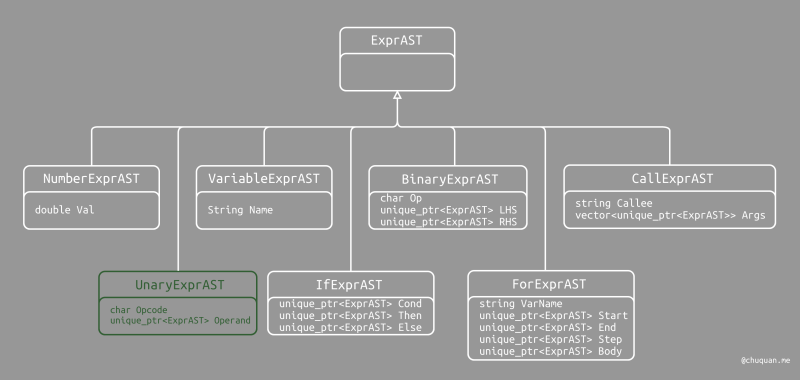基于 LLVM 自制编译器(6)——语言扩展:自定义运算符
概述
目前为止,Kaleidoscope 已经是一门功能齐全且有用的编程语言了。但是,它仍然存在一个很大的问题。当前的 Kaleidoscope 缺少很多有用的运算符,比如:取反、比较等。
本章,我们将为 Kaleidoscope 支持自定义运算符,从而让 Kaleidoscope 具备更强大的编程能力。
目标
我们希望为 Kaleidoscope 支持的 运算符重载(Operator Overloading)能够比 C++ 等语言更加通用。在 C++ 中,我们只能够重新定义已存在的运算符,我们不能以编程方式修改其语法,也不能引入新的运算符、修改运算符优先级等。在本章中,我们将为 Kaleidoscope 支持这种更加强大的能力。
目前为止,我们通过手写的方式实现了一个递归下降的解析器,能够解析目前我们所定义的表达式,包括语法、运算符优先级等。通过运算符优先级解析,我们可以非常简单地引入新的运算符。
本文我们将扩展两种运算符:
- 一元运算符(Unary Operator)
- 二元运算符(Binary Operator)
如下所示,为 Kaleidoscope 中自定义一元运算符和二元运算符的示例。
1
2
3
4
5
6
7
8
9
10
11
12
13
14
15
16
17
18
19
20
21
22
23# Logical unary not.
def unary!(v)
if v then
0
else
1;
# Define > with the same precedence as <.
def binary> 10 (LHS RHS)
RHS < LHS;
# Binary "logical or", (note that it does not "short circuit")
def binary| 5 (LHS RHS)
if LHS then
1
else if RHS then
1
else
0;
# Define = with slightly lower precedence than relationals.
def binary= 9 (LHS RHS)
!(LHS < RHS | LHS > RHS);
词法分析器扩展
无论是一元运算符还是二元运算符,对于词法分析器而言,两者只不过是关键词不同,分别是:unary
和 binary。因此,我们为 unary 和
binary 分别定义对应的 token 类型和 token 值,如下所示。
1 | enum Token { |
运算符的定义解析
从上述的目标可以看出,一元运算符和二元运算符均使用函数的方式进行定义。与普通函数定义不同的是,一元运算符和二元运算符的函数原型略有不同。因此,我们需要对
PrototypeAST 进行修改,从而支持解析两种类型的运算符。
1 | /// PrototypeAST - This class represents the "prototype" for a function, |

我们在原始的 PrototypeAST
定义的基础上,新增两个属性用于表示普通的函数原型和自定义运算符。
IsOperator表示是否是运算符。Precedence表示运算符的优先级。优先级仅用于二元运算符。
通过修改
PrototypeAST,使其支持识别一元运算符和二元运算符的定义后,我们来进一步实现具体的解析逻辑,如下所示。
1 | /// prototype |
在 ParsePrototype 的解析逻辑中,我们通过解析运算符得到
FnName 变量,将其作为自定义运算符的构建名称,比如:为
@ 操作符构建 binary@ 的名称。由于 LLVM
符号表中的符号允许包含任何字符,所以我们可以将构建名称(如:binary@)存入符号表。
这里,一元运算符和二元运算符的定义的解析逻辑非常相似,唯一的区别在于,二元运算符需要额外解析运算符优先级。
运算符的表达式解析
上一节,我们介绍了如何解析运算符定义。本节,我们来介绍如何解析运算符表达式。
在第 2 章中,我们已经介绍了 Kaleidoscope 中定义的三种类型的 AST
结构,分别是:表达式、原型、函数。其中,我们已经定义了一种表达式子类型
BinaryExprAST,用于表示二元运算符表达式。因此,我们只需要额外定义一种新的表达式子类型
UnaryExprAST 表示一元运算符表达式即可。

UnaryExprAST
的具体定义如下所示。其中,Opcode
表示运算符符号,Operand 表示运算符所作用的操作数。
1
2
3
4
5
6
7
8
9
10
11/// UnaryExprAST - Expression class for a unary operator.
class UnaryExprAST : public ExprAST {
char Opcode;
std::unique_ptr<ExprAST> Operand;
public:
UnaryExprAST(char Opcode, std::unique_ptr<ExprAST> Operand)
: Opcode(Opcode), Operand(std::move(Operand)) {}
Value *codegen() override;
};
接下来,我们来分别看有一下二元运算符和一元运算符的代码生成实现逻辑。
二元表达式代码生成
如下所示,为二元表达式实现代码生成的逻辑。我们仅仅是在原有的代码生成逻辑中进行了扩展。
1
2
3
4
5
6
7
8
9
10
11
12
13
14
15
16
17
18
19
20
21
22
23
24
25
26
27
28
29
30Value *BinaryExprAST::codegen() {
Value *L = LHS->codegen();
Value *R = RHS->codegen();
if (!L || !R)
return nullptr;
switch (Op) {
case '+':
return Builder.CreateFAdd(L, R, "addtmp");
case '-':
return Builder.CreateFSub(L, R, "subtmp");
case '*':
return Builder.CreateFMul(L, R, "multmp");
case '<':
L = Builder.CreateFCmpULT(L, R, "cmptmp");
// Convert bool 0/1 to double 0.0 or 1.0
return Builder.CreateUIToFP(L, Type::getDoubleTy(TheContext),
"booltmp");
default:
break;
}
// If it wasn't a builtin binary operator, it must be a user defined one. Emit
// a call to it.
Function *F = getFunction(std::string("binary") + Op);
assert(F && "binary operator not found!");
Value *Ops[2] = { L, R };
return Builder.CreateCall(F, Ops, "binop");
}
- 处理
默认运算符,比如:
+、-、*、<等。我们只需要调用Builder生成对应的 LLVM IR 即可。 - 处理
自定义运算符,比如:
@、|等。我们只需要在符号表中查找对应的运算符,并生成对函数(如:binary@)的调用,从而生成 LLVM IR。由于自定义运算符只是作为普通函数构建的,所以不存在额外的特殊逻辑。
一元表达式代码生成
如下所示,为一元表达式实现代码生成的逻辑。 1
2
3
4
5
6
7
8
9
10
11Value *UnaryExprAST::codegen() {
Value *OperandV = Operand->codegen();
if (!OperandV)
return nullptr;
Function *F = getFunction(std::string("unary") + Opcode);
if (!F)
return LogErrorV("Unknown unary operator");
return Builder.CreateCall(F, OperandV, "unop");
}binary!)的调用,从而生成
LLVM IR。
通用表达式解析优化
由于现在我们新增了一种表达式类型
UnaryExprAST,因此,我们需要对原始的通用表达式解析函数进行优化,以支持解析一元表达式。
1
2
3
4
5
6
7
8
9
10/// expression
/// ::= unary binoprhs
///
static std::unique_ptr<ExprAST> ParseExpression() {
auto LHS = ParseUnary();
if (!LHS)
return nullptr;
return ParseBinOpRHS(0, std::move(LHS));
}ParseExpression 的实现逻辑非常简单,使用
ParseUnary
解析左操作数。然后继续解析结果,再解析右操作数。
由于表达式的右部可能也包含一元表达还是,因此,我们还需要修改
ParseBinOpRHS,支持解析一元运算符,如下所示。
1 | /// binoprhs |
上述的修改最终都会调用 ParseUnary
解析函数,其具体实现如下所示。 1
2
3
4
5
6
7
8
9
10
11
12
13
14
15/// unary
/// ::= primary
/// ::= '!' unary
static std::unique_ptr<ExprAST> ParseUnary() {
// If the current token is not an operator, it must be a primary expr.
if (!isascii(CurTok) || CurTok == '(' || CurTok == ',')
return ParsePrimary();
// If this is a unary operator, read it.
int Opc = CurTok;
getNextToken();
if (auto Operand = ParseUnary())
return std::make_unique<UnaryExprAST>(Opc, std::move(Operand));
return nullptr;
}ParseUnary
解析函数的实现非常简单。当我们在解析主表达式时遇到一元运算符时,我们会将运算符符作为前缀,并将剩余部分作为另一个一元运算符进行解析。这样使得我们能够处理多个一元运算符串联的场景,比如:
!!x。注意,一元运算符不能像二元运算符那样具有二义性的解析,因此不需要设置优先级。
运算符函数调用
无论是一元运算符还是二元运算符,最终的实现逻辑均由函数体实现。因此,我们需要通过扩展
FunctionAST 的解析函数
codegen(),从而生成对应的 LLVM IR,具体如下所示。
1
2
3
4
5
6
7
8
9
10
11
12
13
14
15
16
17
18
19
20
21Function *FunctionAST::codegen() {
// Transfer ownership of the prototype to the FunctionProtos map, but keep a
// reference to it for use below.
auto &P = *Proto;
FunctionProtos[Proto->getName()] = std::move(Proto);
Function *TheFunction = getFunction(P.getName());
if (!TheFunction)
return nullptr;
// If this is an operator, install it.
if (P.isBinaryOp())
BinopPrecedence[P.getOperatorName()] = P.getBinaryPrecedence();
// Create a new basic block to start insertion into.
BasicBlock *BB = BasicBlock::Create(TheContext, "entry", TheFunction);
...
if (P.isBinaryOp())
BinopPrecedence.erase(P.getOperatorName());
return nullptr;
其主要是在为 FunctionAST
生成代码时,判断是否是自定义运算符的函数定义,如果是,则设置运算符优先级,并在代码生成后移除对应的运算符优先级。通过这种方式,我们可以同时实现一元运算符和二元运算符的底层代码生成逻辑。
测试
通过以上简单的扩展,我们开发出了一门真正的语言。基于
Kaleidoscope,我们可以做很多有趣的事情,包括:I/O、数学运算等。比如,我们添加一个串联操作符,如下所示。注意:printd
用于打印指定值或换行符。 1
2
3
4
5
6
7
8
9
10
11
12
13
14
15ready> extern printd(x);
Read extern:
declare double @printd(double)
ready> def binary : 1 (x y) 0;
Read function definition:
define double @"binary:"(double %x, double %y) {
entry:
ret double 0.000000e+00
}
ready> printd(123) : printd(456) : printd(789);
123.000000
456.000000
789.000000
Evaluated to 0.000000
我们还可以定义一系列的原始操作符,如下所示。 1
2
3
4
5
6
7
8
9
10
11
12
13
14
15
16
17
18
19
20
21
22
23
24
25
26
27
28
29
30
31
32
33
34
35
36
37
38# Logical unary not.
def unary!(v)
if v then
0
else
1;
# Unary negate.
def unary-(v)
0-v;
# Define > with the same precedence as <.
def binary> 10 (LHS RHS)
RHS < LHS;
# Binary logical or, which does not short circuit.
def binary| 5 (LHS RHS)
if LHS then
1
else if RHS then
1
else
0;
# Binary logical and, which does not short circuit.
def binary& 6 (LHS RHS)
if !LHS then
0
else
!!RHS;
# Define = with slightly lower precedence than relationals.
def binary = 9 (LHS RHS)
!(LHS < RHS | LHS > RHS);
# Define ':' for sequencing: as a low-precedence operator that ignores operands
def binary : 1 (x y) y;
总结
至此,Kaleidoscope 开始成为一种真实而强大的语言。
通过本章,我们增强了 Kaleidoscope 语言,在库中添加了扩展语言的能力。此时,Kaleidoscope 可以构建各种功能性的应用程序,并且可以调用具有副作用的函数,但它实际上不能定义和改变变量本身。
然而,变量更新是大多数编程语言的一个重要特性。下一章,我们将描述如何在不在前端构建 SSA 的情况下支持变量更新。
